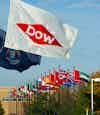Published
October 26, 2020
In January, Jeff Martin, a corporate communications advisor at Dow, was asked by the company’s pandemic team to draft a proposed travel advisory due to a virus that was emerging in Wuhan, China.
“That's where it all started,” Martin said. “And I’m that person that when crises come, I get involved.”
Martin has been a continuous witness to the multinational chemical company’s response to the coronavirus pandemic. As the threat of the virus escalated, a corporate crisis management team was quickly put together to manage any day-to-day work involving the virus with input from Dow’s CEO and other executive leaders. As the virus progressed into different regions around the world, regional crisis management teams were activated in areas being impacted.
“It took its time to get to North America, but once that happened our whole company was fully engaged,” Martin said.
Headquartered in Midland, Michigan, Dow manufactures the raw materials behind 96% of the products people use every day including personal protective equipment such as hand sanitizer, disinfectants, IV bags, surgical masks, and disposal gloves. With 109 manufacturing sites in 31 countries, the company was closely tapped into the impact the virus was having in other regions well before the first cases were detected in the United States.
Designated an essential business, Dow knew it needed to keep its manufacturing going (with some operational changes at facilities to enforce social distancing, etc.), but the challenging thing, Martin said, was that governments, states, and communities were handling things very differently across the globe.
“We all came together as a crisis management support team, assisting all the regional teams around the world, to ensure a cohesive path forward on what we were going to do as a company with our employees and in the communities we operate,” Martin said.
Over the past eight months, Dow’s pandemic-relief efforts have ramped up to include innovating and pivoting their supply chains to produce essential products, utilizing the Dow Company Foundation to donate generously to populations in need, and prioritizing helping the local communities where their employees live and work.
Meeting a Critical Need
No matter what, first and foremost Dow had to stay open. It produced the ingredients needed to make the very products that citizens were lining up to get their hands on, and that medical providers and first responders were desperate to secure, including cleaning products and sanitizers, cleaning agents, masks, medical gowns, face shields, and more.
“The materials we produce are fundamental to the products that are so important for the economy, and the continuation of the supply chain for consumers and medical professionals,” said Christine Miller, director of global employee engagement and reputation and North America public affairs. “It was so important that we continued to operate.”
Dow forged full steam ahead on its day-to-day manufacturing, but at the same time explored innovative avenues and partnerships with other companies to have an even greater impact.
In late March, with medical, health and hygiene products in short supply, Dow announced that five of their manufacturing sites across the globe in Michigan, West Virginia, Belgium, Germany, and Brazil, had the raw materials and capability to produce hand sanitizer with little to no impact on their normal operations.
The collective output of all five sites reached more than 440,000 pounds of sanitizer (200 metric tons) per week, or the equivalent of more than 880,000 eight-ounce bottles. Most of the sanitizer was donated to health systems and government agencies for distribution, and some was used in Dow’s own facilities to protect employee’s health and safety.

Dow manufacturing site in Freeport, Texas.
In April, the company developed a design for face shields to help protect healthcare professionals and shared the open-source design to encourage additional production. Dow is a leading manufacturer of polyethylene resins but wouldn't typically create plastic products for direct consumer use. But Dow’s experts from multiple business units, including Plastics and Polyurethanes, quickly developed the resin film technology through its prototyping and fabricating capabilities and worked with partners to source a comfort foam strip for the shield’s design.
Writing on the face shield collaboration (with Michigan small business tinkrLab), Dow Chairman and CEO Jim Fitterling said: “Individually we each may only play a small part in easing the uncertainty our planet currently faces. But at Dow, we believe in and continue to witness the power of partnership.”
And Dow didn't stop at hand sanitizer and face shields. Its most innovative and ambitious collaboration rolled out in May when the company teamed up with Whirlpool Corporation and Reynolds Consumer Products to create respirators for frontline healthcare workers. The powered, air-purifying respirator, or PAPR, takes the place of a traditional medical mask and visor and features a replaceable polyethylene hood. The clear hoods are both flexible and comfortable and can quickly be replaced between patients.
Whirlpool Corporation and Dow led the design, development and testing of the PAPR system. Whirlpool manufactured and assembled the PAPR (including the air supply system and headset). Dow provided the polyethylene resin for the disposable hoods, and teamed up with Reynolds Consumer Products, makers of Hefty® brand, to design and produce the disposable hood and donated the first one million to health care workers. Volkswagen of America connected the team with materials and supply chain partners to source some of the components.
Each company was looking to help, and through those efforts a creative, agile team was able to accelerate the design process and go from paper to approved product in just seven weeks. Two thousand respirators were produced and donated in the first phase of production. Whirlpool Corporation currently makes the PAPRs available at low cost through their subsidiary WIN Health Labs, LLC.
“This collaboration is a testament to the private sector’s continued commitment and quick actions to work across industries to innovate healthcare solutions at a time of unprecedented need,” Fitterling said in a statement on the partnership.
And the list of innovative COVID-19 relief partnerships goes on: a collaboration with SC Johnson to make hand sanitizer; a partnership with nine other companies including 3M, Magna International, and Shurtape to produce medical isolation gowns; and joining Ortobom, a mattress company, in donating a thousand mattresses to hospitals in Brazil.
“The focus on partnerships comes from our strong relationships with our customers,” said Rachelle Schikorra, director of corporate communications at Dow. “Industry came together and said we need to help."
A Generous Response
Meanwhile, as the business and manufacturing teams were exploring ways to combat the pandemic with supplies and materials, Dow’s philanthropic teams were hard at work, too.
On January 29, Dow made its first COVID-19 related philanthropic donation to Shenzhen One Foundation in China to purchase medical supplies for hospitals in Hubei Province. A day later, the company announced $30,000 in additional donations from the Dow Company Foundation to work with the China Development Research Foundation to send medical supplies to poverty-stricken areas.
In March, Dow announced a commitment of $3 million to help fund global relief efforts including a donation to the COVID-19 Solidarity Fund to support the World Health Organization efforts around the world, a donation to Direct Relief to distribute medical supplies, and support for local and regional non-profit organizations in Dow communities around the world.
More recently, Dow partnered with Citi and LEAP Africa, a youth-focused leadership development NGO, to provide support to low income communities affected by COVID-19 in Nigeria; and partnered with Foodbank Victoria to provide more than 28,000 meals to underprivileged families impacted by COVID-19 in Australia.
Close connections to NGOs and businesses around the world put the company in a unique position to harness all their resources and be a leader in an ambitious effort to do good. In total, the Dow Company Foundation committed $3.7 million around the world to frontline workers and nonprofits.
“That made a big difference in the communities where we operate, to our employees, to our key stakeholders, and to the communities at large,” said Dow Company Foundation President Nancy Lamb.
A Dual Responsibility
With more than 36,500 employees globally, and more than 14,000 employees working at essential manufacturing sites around the world since the beginning of the pandemic, Dow was proactive in ensuring its own employees were working in a safe and healthy environment.
“It was very important to us that we understood and maintained safety,” said Miller. “Everything from the way that we interact in the control room, to the way that we handle work permits – all of these things had to change.”
Dow sites began temperature checks for employees and contractors to reduce the risk of potential exposure, increased cleaning, and changed work procedures to increase social distancing between coworkers. The company made sure hand sanitizer and disinfectant wipes were widely available, posted guidelines about COVID-19 health and safety practices at entrances and exits, and stocked up on a supply of personal protective equipment.
When non-essential businesses started reopening in May and June, Dow had months of insight to share on the safest ways to bring employees back into the workplace – and published their 50-page Return to Workplace Playbook to detail their phased reopening strategy. The plan builds on lessons Dow learned from colleagues in Asia, and incorporates insights gathered from Dow employees who continued reporting to work during the shutdowns.
The playbook also includes a signage library, how-to documents for procedures on self-isolating and temperature screenings, and dozens of other resources on prevention and testing, employee well-being, and other general information.
“We used our chemistries and our capabilities to do what we could and played a role in not just keeping the company going but also trying to help protect the world,” Martin said. “We’re now just working toward getting back to work, that’s our major focus right now.”
For more information and a full timeline of Dow’s efforts to combat the COVID-19 pandemic, visit corporate.dow.com.
About the authors

Lindsay Cates
Lindsay is a senior manager on the communications and strategy team. She previously worked as a writer and editor at U.S. News and World Report.

